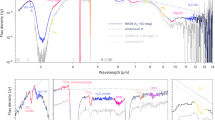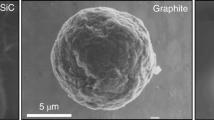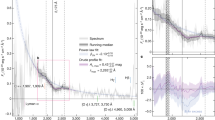Abstract
Clouds of gas and dust in the Galaxy are nurseries in which stars and planetary systems are born. During their journey from the diffuse interstellar medium to the protoplanetary disks, molecular solids accumulate on cold dust grains by accretion and surface chemistry. These so-called icy grains will continuously evolve, notably by collision and aggregation processes, modifying their sizes. Our ‘Ice Age’ James Webb Space Telescope observations of the dense Chamaeleon I cloud reveal that this growth starts early, before the protostellar phase, substantially modifying the ice band profiles in the spectra. Spectral analysis confirms that the grains reach micrometre sizes, implying myriad changes in local microphysics, including mass transfer from small to large grains, reduction in the grain surface available for chemistry and modification of the penetration and propagation of radiation fields. Deformation of the observed profiles complicates the determination of chemical abundance. Observing the extensive icy grain growth in dense clouds quantitatively constrains the grain size evolution before star and planet formation.
This is a preview of subscription content, access via your institution
Access options
Access Nature and 54 other Nature Portfolio journals
Get Nature+, our best-value online-access subscription
$29.99 / 30 days
cancel any time
Subscribe to this journal
Receive 12 digital issues and online access to articles
$119.00 per year
only $9.92 per issue
Buy this article
- Purchase on Springer Link
- Instant access to full article PDF
Prices may be subject to local taxes which are calculated during checkout



Similar content being viewed by others
Data availability
Observational raw data are publicly available in the STScI MAST JWST archive. Text files of observed enhanced one-dimensional spectra, including error bars, are provided as part of our Early Release Science enabling product deliverables on Zenodo at https://doi.org/10.5281/zenodo.7501239. Data files of optical constants of amorphous carbon from ref. 39 are available at the CDS via anonymous ftp to cdsarc.u-strasbg.fr (130.79.128.5) or via http://cdsarc.u-strasbg.fr/viz-bin/qcat?J/A+A/545/C2; optical constants of silicates are described in ref. 38; pure carbon monoxide ice optical constants from ref. 43 can be retrieved from the Catania Experimental Astrophysics Laboratory at the URL http://www.ct.astro.it/lasp/optico.html. The optical constants of ice mixtures can be retrieved from the DREAM database at http://www.dream-database.fr/.
Code availability
The grain growth model was run using a custom code, incorporating publicly available elements, such as DDSCAT (v.7.3), as described in ref. 37 (http://www.ddscat.org), and RADMC-3D radiative transfer code, as described in ref. 48 (https://www.ita.uni-heidelberg.de/~dullemond/software/radmc-3d/). The POV-Ray tool was used for some illustrations (http://www.povray.org/).
References
Mathis, J. S., Rumpl, W. & Nordsieck, K. H. The size distribution of interstellar grains. Astrophys. J. 217, 425–433 (1977).
McClure, M. Observational 5-20 μm interstellar extinction curves toward star-forming regions derived from Spitzer IRS spectra. Astrophys. J. 693, L81–L85 (2009).
Flaherty, K. M. et al. Infrared extinction toward nearby star-forming regions. Astrophys. J. 663, 1069–1082 (2007).
Chapman, N. L., Mundy, L. G., Lai, S.-P., Evans, I. & Neal, J. The mid-infrared extinction law in the Ophiuchus, Perseus, and Serpens molecular clouds. Astrophys. J. 690, 496–511 (2009).
Jones, A. P. et al. Mantle formation, coagulation, and the origin of cloud/core shine. I. Modelling dust scattering and absorption in the infrared. Astron. Astrophys. 588, A43 (2016).
Weingartner, J. C. & Draine, B. T. Dust grain-size distributions and extinction in the Milky Way, Large Magellanic Cloud, and Small Magellanic Cloud. Astrophys. J. 548, 296–309 (2001).
Madden, M. C. L. et al. Infrared spectroscopic survey of the quiescent medium of nearby clouds. II. Ice formation and grain growth in Perseus and Serpens. Astrophys. J. 930, 2 (2022).
Ysard, N., Koehler, M., Jimenez-Serra, I., Jones, A. P. & Verstraete, L. From grains to pebbles: The influence of size distribution and chemical composition on dust emission properties. Astron. Astrophys. 631, A88 (2019).
Boogert, A. C. A. et al. Infrared spectroscopic survey of the quiescent medium of nearby clouds. I. Ice formation and grain growth in Lupus. Astrophys. J. 777, 73 (2013).
van Breemen, J. M. et al. The 9.7 and 18 μm silicate absorption profiles towards diffuse and molecular cloud lines-of-sight. Astron. Astrophys. 526, A152 (2011).
Chiar, J. E. et al. The relationship between the optical depth of the 9.7 μm silicate absorption feature and infrared differential extinction in dense clouds. Astrophys. J. Lett. 666, L73–L76 (2007).
Ysard, N. et al. Mantle formation, coagulation, and the origin of cloud/core shine. II. Comparison with observations. Astron. Astrophys. 588, A44 (2016).
Saajasto, M., Juvela, M. & Malinen, J. Near-infrared scattering as a dust diagnostic. Astron. Astrophys. 614, A95 (2018).
Steinacker, J. et al. Grain size limits derived from 3.6 μm and 4.5 μm coreshine. Astron. Astrophys. 582, A70 (2015).
Marchand, P., Guillet, V., Lebreuilly, U. & Mac Low, M. M. Fast methods for tracking grain coagulation and ionization. II. Extension to thermal ionization. Astron. Astrophys. 666, A27 (2022).
Silsbee, K., Ivlev, A. V., Sipilä, O., Caselli, P. & Zhao, B. Rapid elimination of small dust grains in molecular clouds. Astron. Astrophys. 641, A39 (2020).
Lebreuilly, U., Commerçon, B. & Laibe, G. Small dust grain dynamics on adaptive mesh refinement grids. I. Methods. Astron. Astrophys. 626, A96 (2019).
Paruta, P., Hendrix, T. & Keppens, R. Dust grain coagulation modelling: From discrete to continuous. Astronomy and Computing 16, 155–165 (2016).
Ormel, C. W. An atmospheric structure equation for grain growth. Astrophys. J. Lett. 789, L18 (2014).
Smith, R. G., Sellgren, K. & Tokunaga, A. T. Absorption features in the 3 micron spectra of protostars. Astrophys. J. 344, 413 (1989).
Dartois, E., d’Hendecourt, L., Thi, W., Pontoppidan, K. M. & van Dishoeck, E. F. Combined VLT ISAAC/ISO SWS spectroscopy of two protostellar sources. The importance of minor solid state features. Astron. Astrophys. 394, 1057–1068 (2002).
Noble, J. A., Fraser, H. J., Aikawa, Y., Pontoppidan, K. M. & Sakon, I. A survey of H2O, CO2, and CO ice features toward background stars and low-mass young stellar objects using Akari. Astrophys. J. 775, 85 (2013).
McClure, M. K. et al. An Ice Age JWST inventory of dense molecular cloud ices. Nat. Astron. 7, 431–443 (2023).
Gibb, E. L., Whittet, D. C. B., Boogert, A. C. A. & Tielens, A. G. G. M. Interstellar ice: The infrared space observatory legacy. Astrophys. J. Suppl. Ser. 151, 35–73 (2004).
Dartois, E. The ice survey opportunity of ISO. Space Sci. Rev. 119, 293–310 (2005).
Boogert, A. C. A., Gerakines, P. A. & Whittet, D. C. B. Observations of the icy universe. Annu. Rev. Astron. Astrophys. 53, 541–581 (2015).
Dartois, E., Noble, J. A., Ysard, N., Demyk, K. & Chabot, M. Influence of grain growth on CO2 ice spectroscopic profiles. Modelling for dense cores and disks. Astron. Astrophys. 666, A153 (2022).
Ehrenfreund, P., Boogert, A., Gerakines, P. & Tielens, A. Apolar ices. Faraday Discussions 109, 463 (1998).
Dartois, E. & Bauerecker, S. Infrared analysis of CO ice particles in the aerosol phase. J. Chem. Phys. 128, 154715 (2008).
Dartois, E. Spectroscopic evidence of grain ice mantle growth in YSOs. I. CO ice modeling and limiting cases. Astron. Astrophys. 445, 959–970 (2006).
Dartois, E. & d’Hendecourt, L. Search for NH3 ice in cold dust envelopes around YSOs. Astron. Astrophys. 365, 144–156 (2001).
van Broekhuizen, F. A., Pontoppidan, K. M., Fraser, H. J. & van Dishoeck, E. F. A 3–5 m VLT spectroscopic survey of embedded young low mass stars II: Solid OCN. Astron. Astrophys. 441, 249–260 (2005).
Boogert, A. C. A., Brewer, K., Brittain, A. & Emerson, K. S. Survey of ices toward massive young stellar objects. I. OCS, CO, OCN−, and CH3OH. Astrophys. J. 941, 32 (2022).
Ormel, C. W., Paszun, D., Dominik, C. & Tielens, A. G. G. M. Dust coagulation and fragmentation in molecular clouds. I. How collisions between dust aggregates alter the dust size distribution. Astron. Astrophys. 502, 845–869 (2009).
Husser, T. O. et al. A new extensive library of PHOENIX stellar atmospheres and synthetic spectra. Astron. Astrophys. 553, A6 (2013).
Palacios, A. et al. POLLUX: a database of synthetic stellar spectra. Astron. Astrophys. 516, A13 (2010).
Draine, B. T. & Flatau, P. J. User guide for the discrete dipole approximation code DDSCAT 7.3. Preprint at https://arxiv.org/abs/1305.6497 (2013).
Köhler, M., Jones, A. & Ysard, N. A hidden reservoir of Fe/FeS in interstellar silicates? Astron. Astrophys. 565, L9 (2014).
Jones, A. P. Variations on a theme—the evolution of hydrocarbon solids. II. Optical property modelling—the optEC(s) model. Astron. Astrophys. 540, A2 (2012).
Godard, M., Geballe, T. R., Dartois, E. & Muñoz Caro, G. M. The deep 3.4 μm interstellar absorption feature toward the IRAS 18511+0146 cluster. Astron. Astrophys. 537, A27 (2012).
Pendleton, Y. J., Sandford, S. A., Allamandola, L. J., Tielens, A. G. G. M. & Sellgren, K. Near-infrared absorption spectroscopy of interstellar hydrocarbon grains. Astrophys. J. 437, 683 (1994).
Zhu, H., Tian, W., Li, A. & Zhang, M. The gas-to-extinction ratio and the gas distribution in the Galaxy. Mon. Not. R. Astron. Soc. 471, 3494–3528 (2017).
Palumbo, M. E., Baratta, G. A., Collings, M. P. & McCoustra, M. R. S. The profile of the 2140 cm-1 solid CO band on different substrates. Phys. Chem. Chem. Phys. 8, 279–284 (2006).
Dartois, E. et al. Cosmic ray sputtering yield of interstellar ice mantles. CO and CO2 ice thickness dependence. Astron. Astrophys. 647, A177 (2021).
Rocha, W. R. M. et al. LIDA: The Leiden Ice Database for Astrochemistry. Astron. Astrophys. 668, A63 (2022).
Ehrenfreund, P. et al. Laboratory studies of thermally processed H2O-CH3OH-CO2 ice mixtures and their astrophysical implications. Astron. Astrophys. 350, 240–253 (1999).
Dartois, E. Les glaces interstellaires: interpretation par simulations en laboratoire des observations du satellite ISO. PhD thesis, Paris-VI (1998).
Dullemond, C. P. et al. RADMC-3D: A multi-purpose radiative transfer tool. Astrophysics Source Code Library, record ascl 1202, 015 (2012).
Bouilloud, M. et al. Bibliographic review and new measurements of the infrared band strengths of pure molecules at 25 K: H2O, CO2, CO, CH4, NH3, CH3OH, HCOOH and H2CO. Mon. Not. R. Astron. Soc. 451, 2145–2160 (2015).
Luna, R. et al. Densities, infrared band strengths, and optical constants of solid methanol. Astron. Astrophys. 617, A116 (2018).
Bottinelli, S. et al. The c2d Spitzer spectroscopic survey of ices around low-mass young stellar objects. IV. NH3 and CH3OH. Astrophys. J. 718, 1100–1117 (2010).
Molpeceres, G. et al. Optical constants and band strengths of CH4:C2H6 ices in the near- and mid-infrared. Astrophys. J. 825, 156 (2016).
van Broekhuizen, F. A., Keane, J. V. & Schutte, W. A. A quantitative analysis of OCN− formation in interstellar ice analogs. Astron. Astrophys. 415, 425–436 (2004).
Theule, P. et al. Kinetics of the OCN− and HOCN formation from the HNCO + H2O thermal reaction in interstellar ice analogs. Astron. Astrophys. 530, A96 (2011).
Gálvez, O., Maté, B., Herrero, V. J. & Escribano, R. Ammonium and formate ions in interstellar ice analogs. Astrophys. J. 724, 539–545 (2010).
Acknowledgements
We dedicate this article to the memory of Professor Harold Linnartz, our dear friend and colleague, who will be sadly missed by the whole Ice Age team. E.D., J.A.N., A.T. and V.W. acknowledge the support from the French Programme National ‘Physique et Chimie du Milieu Interstellaire’ of the CNRS/INSU with the INC/INP, co-funded by the CEA and the CNES. I.J.-S. acknowledges the financial support from grant number PID2019-105552RB-C41 by the Spanish Ministry of Science and Innovation/State Agency of Research MCIN/AEI/10.13039/501100011033. B.M. and V.J.H. acknowledge funding from the Spanish MIC grant PID2020-113084GB-I00/AEI/10.13039/501100011033. M.K.M. acknowledges the financial support from the Dutch Research Council (NWO; grant VI.Veni.192.241). Z.L.S. acknowledges financial support from the Royal Astronomical Society through the E. A. Milne Travelling Fellowships. A.C.A.B. and J.E. acknowledge support from the Space Telescope Science Institute for the programme JWST-ERS-01309.019. M.N.D. acknowledges the Swiss National Science Foundation Ambizione grant number 180079, Center for Space and Habitability Fellowship and IAU Gruber Foundation Fellowship. D.H. is supported by the Center for Informatics and Computation in Astronomy grant and from the Ministry of Education of Taiwan (grant number 110J0353I9). D.H. acknowledges support from the National Technology and Science Council of Taiwan through grant number 111B3005191. S.I. and H.L. acknowledge support from the Danish National Research Foundation through the Center of Excellence ‘InterCat’ (grant agreement number DNRF150). W.R.M.R. acknowledges support from the European Research Council under the European Union’s Horizon 2020 research and innovation programme (grant agreement number 101019751 MOLDISK).
Author information
Authors and Affiliations
Contributions
Authorship is defined according to the CRediT taxonomy: E.D. was involved with conceptualisation, the methodology, software, validation, formal analysis, investigation, resources, writing of the original draft, reviewing and editing, visualisation, supervision and project administration. J.A.N. was involved with conceptualisation, the methodology, validation, formal analysis, investigation, resources, writing of the original draft, review and editing, visualisation, supervision, project administration and funding acquisition. P.C. was involved with investigation and writing of the original draft. H.J.F. was involved with methodology, validation, investigation, review and editing and project administration. I.J.-S. was involved with investigation, writing of the original draft and project administration. B.M. was involved with the methodology, validation, formal analysis, investigation and writing of the original draft. M.K.M. was involved with the methodology, validation, formal analysis, investigation, writing of the original draft, supervision, project administration and funding acquisition. G.J.M. and Y.J.P. were involved in the investigation and writing of the original draft. T.S. and Z.L.S. were involved in the methodology, validation, formal analysis and investigation. J.A.S. was involved in the investigation and writing of the original draft. A.T. was involved in the investigation, writing of the original draft and visualisation. V.W. was involved in the investigation and writing of the original draft. A.C.A.B. reviewed and edited the paper and was involved with project administration. M.N.D., J.E., D.H., S.I., B.A.M., G.P., D.Q. and W.R.M.R. reviewed and edited the paper. V.J.H. was involved with validation, the investigation and writing of the original draft. H.L. reviewed and edited the paper and was involved with project administration.
Corresponding author
Ethics declarations
Competing interests
The authors declare no competing interests.
Peer review
Peer review information
Nature Astronomy thanks the anonymous reviewers for their contribution to the peer review of this work.
Additional information
Publisher’s note Springer Nature remains neutral with regard to jurisdictional claims in published maps and institutional affiliations.
Supplementary information
Supplementary Information
Supplementary Figs. 1–3 and Discussion.
Rights and permissions
Springer Nature or its licensor (e.g. a society or other partner) holds exclusive rights to this article under a publishing agreement with the author(s) or other rightsholder(s); author self-archiving of the accepted manuscript version of this article is solely governed by the terms of such publishing agreement and applicable law.
About this article
Cite this article
Dartois, E., Noble, J.A., Caselli, P. et al. Spectroscopic sizing of interstellar icy grains with JWST. Nat Astron 8, 359–367 (2024). https://doi.org/10.1038/s41550-023-02155-x
Received:
Accepted:
Published:
Issue Date:
DOI: https://doi.org/10.1038/s41550-023-02155-x
This article is cited by
-
Diagnosing grain growth in a dense cloud with JWST
Nature Astronomy (2024)



